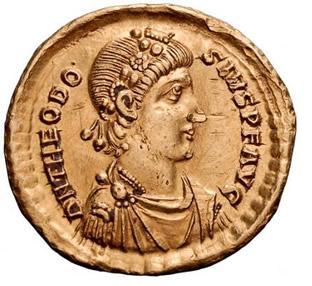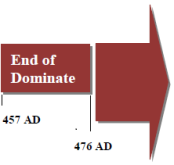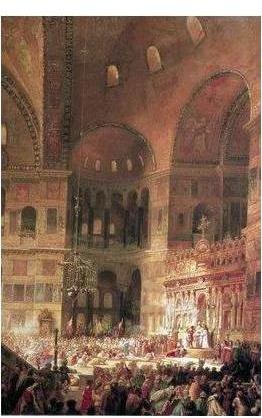The Roman Dominate (284 - 476 AD)
Click on any of the boxes below pertaining to each emperor/dynasty:
Diocletian (reign: 284 - 305 AD)
Updated on: 14 May 2023Reading time: 5 minutes
The Roman Dominate began with the reign of Diocletian. He was a competent emperor who restored political stability, ended the economic depression, and defeated barbarian tribes. To achieve stability, he created the Tetrarchy, dividing the Empire among four emperors or tetrarchs. Diocletian himself was one of the emperors in the East, along with Galerius, while the two emperors in the West were Flavius and Constantius.
Rome became a true republic again and was more democratic than ever before during the Empire. It is also worth noting that Rome was no longer the capital of the Empire, and the capital became Mediolanum (today's Milan) from 286 to 330 AD. To achieve economic stability, Diocletian implemented important tax reforms.
Diocletian adopted many Eastern customs that were unusual in Rome, such as the practice of people bowing down to him in his presence and wearing jewelry and golden sandals. He is also remembered for his persecution of the Christians, who were seen as a threat to the political order. In 303 AD, he ordered the destruction of all Christian churches and scripts, and the practice of Christianity was punishable by death. Diocletian resigned in 305 AD, becoming the first Roman emperor to do so.
Constantine (reign: 306 - 337 AD)
During the Roman Dominate, Constantine was one of the tetrarchs in 306 AD. However, the empire lost the political stability that it had enjoyed during the reign of Diocletian. Constantine engaged in war with one of the other tetrarchs, Maxentius, and defeated him in 312 AD. He also went to war with tetrarch Licinius and defeated him in 324 AD, thereby taking full control of the empire. Additionally, Constantine defeated the Franks and the Alamanni in 306-308 AD.Constantine is mainly remembered for converting Rome to Christianity. In 313 AD, the Edict of Milan allowed Christianity in the empire and all Romans were free to practice this religion. Other religions were allowed, but Christianity received preferential treatment and various privileges. Constantine himself converted to Christianity and even enforced the Christian faith throughout the Empire.
He also made a bold move by changing the capital of the Empire. He rebuilt Byzantium, renamed it Nova Roma, and made it the center of Christianity. The city, however, quickly became known as Constantinople ("the city of Constantine" in Greek). Constantine made important changes in the economy, such as dramatically increasing taxes across the board. However, the currency, the solidus, became stable, and the economy began developing again.
The Constantinian and Valentian dynasties (337 - 378 AD)
Towards the end of this dynasty, Rome lost some important battles. In 363 AD, in the Battle of Samarra, the emperor Julian the Apostate lost against the Persians and was killed during the battle. Emperor Valens (reign: 364-378 AD) lost his life in the Battle of Adrianople in 378 AD against the Goths. This weakened the Roman Dominate as the Goths were never expelled and never became integrated into Roman society.

|
Theodosian dynasty (379-423 AD in the West, 457 AD in the East)
Theodosius (reign: 379-395 AD) strengthened Christianity and made it the official state religion. He also fortified the walls of Constantinople, making the city impenetrable until the 13th century. After his death, the empire was divided again into the Eastern and Western Roman Empire. His son Arcadius (reign: 395-408 AD) ruled the Eastern Empire, while his other son Honorius (reign: 395 - 423 AD) ruled the Western Empire.In 402, Ravenna became the capital of the Western Roman Empire. General Stilicho, who had Vandal origins, served as regent for the underage emperor Honorius. Stilicho had many victories and sought to reunite the empire but was removed from power and executed in 408 AD, partly due to military disasters despite his previous successes. His execution weakened the army and led to the Visigoth invasion and sack of Rome in 410 AD (although Rome was no longer the capital).
The end of the Roman Dominate and of the Western Roman Empire (410 - 476 AD)
The Western Empire lost significant territory after General Stilicho's death. Britain was abandoned, Gaul was conquered by the Visigoths, Hispania by the Suebi, and North Africa by the Vandals. Attila the Hun also led invasions. Many of the barbarians had learned Rome's military tactics by enrolling in the Roman army and fighting wars for Rome.A group of barbarians led by Odoacer, who were inside the Roman army, made demands to Roman General Orestes. When the General refused to meet their demands and tried to expel them from Italy, Odoacer went to war with Orestes and killed him. Odoacer then invaded Ravenna in 476 AD and removed Romulus Augustus, son of Orestes, from power. This event marked the end of the Roman Dominate and of the Western Roman Empire.
SOURCES
- A History Of The Roman Empire: From Its Foundation To The Death Of Marcus Aurelius, 27 B.C. To 180 A.D. (J. B. Bury, Kessinger Publishing, 2010)
- Aurelian and the Third Century (A. Watson, Routledge 1st edition, 2003)
- The Roman Empire from Severus to Constantine (P. Southern, Routledge 2nd edition, 2015)
- History of the Later Roman Empire: From the Death of Theodosius I to the Death of Justinian, Volume 1 (J. B. Bury, Dover Publications, 2011)
- Consuls of the Later Roman Empire ( R. S. Bagnall, A. Cameron, S. R. Schwartz, K. A. Worp, Oxford University Press 1st edition, 1987)






